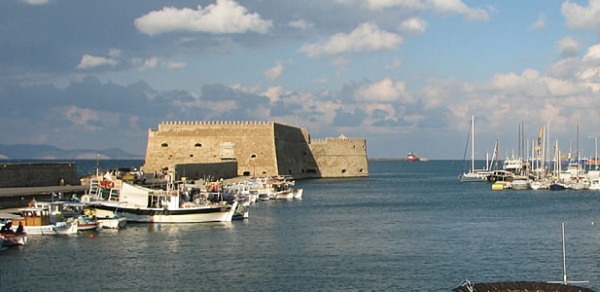The Venetian Marine Fortress of Heraklion
The Venetian fortress “Rocca a Mare”, “Castello a Mare”, “Castello”, “Su Kulesi” or “Koules” is situated at the entrance to the Venetian harbor of Heraklion.
It is one of the so-called marine fortresses which functioned as forward bastions on the sea within the framework of more general architectural planning. It was occasionally combined with protection of the commercial harbor and docks, as was the case here.
According to historical testimony, there was probably a tower at the same site during the second Byzantine or even the Arab period. We do not know what form the fortress had during the first period of the Venetian rule. Early 16th c. Venetian documents mention that the tower had suffered damages and was practically in ruins. With the prevalence of the bastion system (fronte bastionato) and radical changes in the form of fortifications, the old fortress could not meet the new defensive needs created by the use of cannons, and so in 1523 it was decided to demolish it and build it over in accordance with the bastion system. Construction of the new fortress was completed around 1540.
It formed an inseparable part of the new Venetian fortifications of the city. The fortress’s main axis was oriented towards the East to protect the harbor and the east coast, while its north-northwestern side controlled the Bay of Candia, the coastal wall, and the Cretan sea. The fortress is built atop a natural rocky outcrop, which the Venetians were compelled to supplement by sinking old galleons filled with rocks, gravel and boulders transported from Fraskia and Dia. The fortress has two storeys, and in its final form covered a total area of around 3,600 square meters.
On the ground floor, which was vaulted with openings for ventilation and lighting ending at the dome, there were 26 separate rooms used as storerooms for food and munitions, a meeting hall, and a prison. The water reservoir was also on the ground floor. Access to the upper storey was achieved by a staircase and a ramp used for moving firearms. There are projections on the walls that probably supported a wooden mezzanine floor to provide troop quarters. The upper floor is configured in two levels; it provided accommodations for the governor (castellano)and officers of the garrison, a bakery, a mill, a small church and a lighthouse. Three marble compositions with the Winged Lion, the symbol of Saint Mark (Venice’s patron saint) were built into the facades of Koules. The first is set above the main gate on the western side of the fortress. At its base is an inscription with the name of the Doge Andrea Gritti (1533-1534). The second is above the northern gate; at its base is an inscription bearing the names of the Doge Andrea Gritti, the Duke of Crete Domenico Capello, the capitano generale Gerolamo Zane, and the councillors (consiglieri) Marcantonio Diedo and Nicolo Marcello (1533). The third composition on the fortress’s southern facade is simpler.
During the Ottoman period the fortress underwent repairs and interventions, chiefly to its upper storey, where battlements, gun ports, and a small mosque were added. Many Cretan revolutionaries were imprisoned in the fortress’s cells, Daskalogiannis among them.
The fortress has been repeatedly repaired due to the great force of the sea, which continues today to cause damage to its masonry and foundations.




